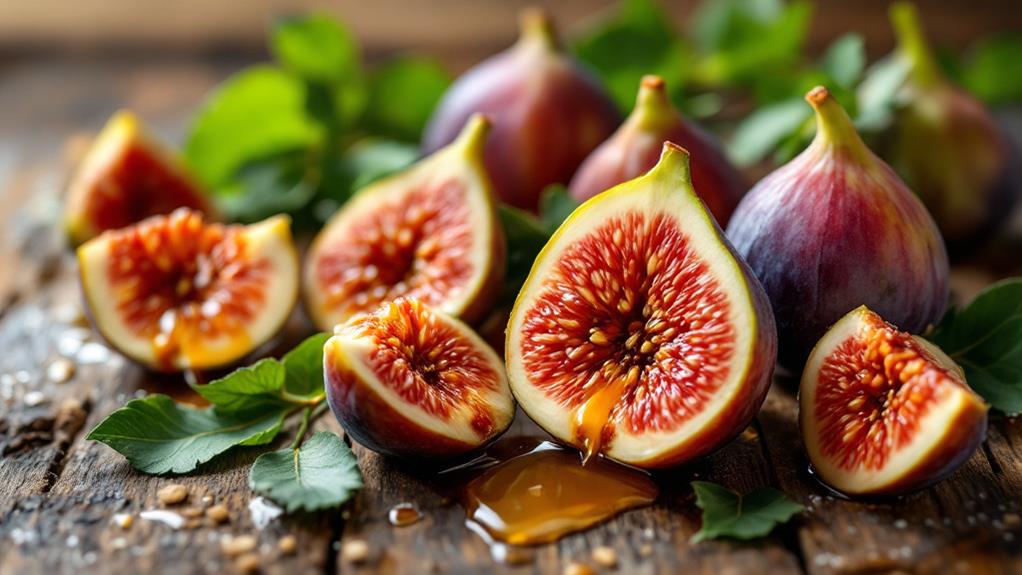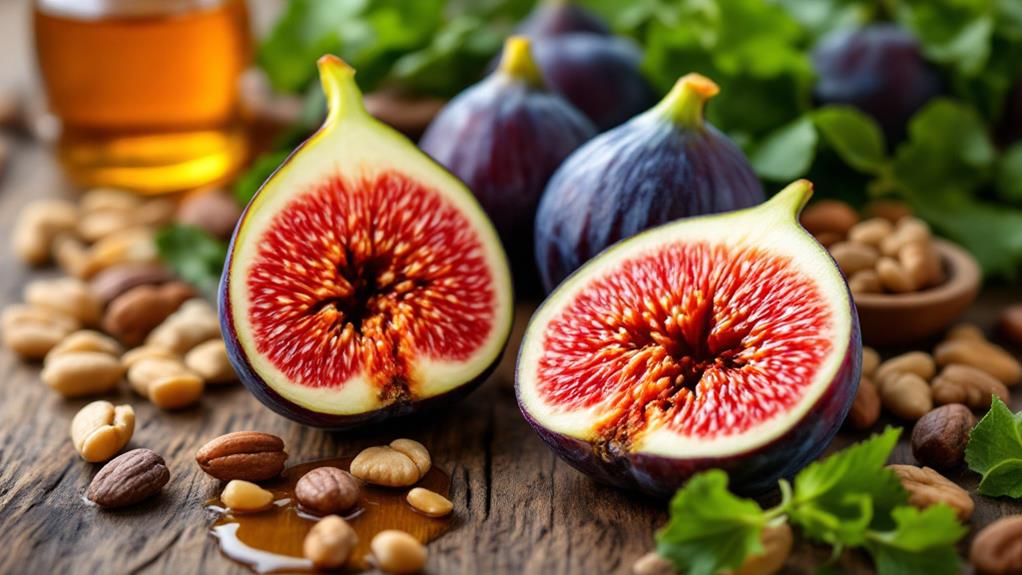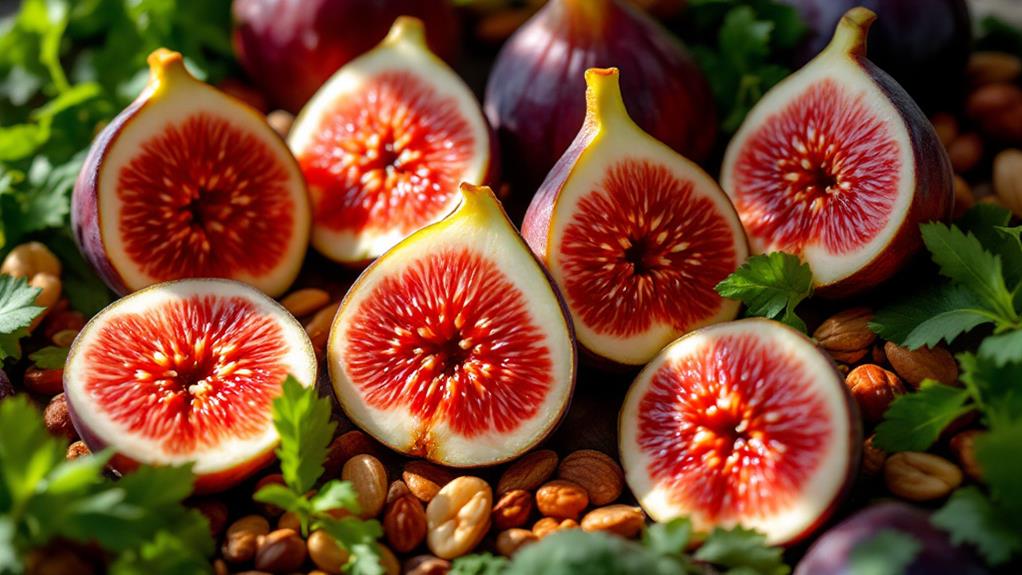Fun Facts About Figs: Why This Fruit Is a Nutritional Powerhouse

You'll be amazed by figs, a true nutritional powerhouse with a rich history and a multitude of health benefits. They trace back to the Neolithic period and over 700 varieties enrich your diet with diverse flavors, colors, and textures. Fresh figs are low in calories but high in fiber and antioxidants, supporting digestive health and reducing disease risk. Dried figs pack a punch with crucial minerals like calcium and potassium, fundamental for your bone and heart health. With numerous culinary applications, figs offer sweetness and nutrition to any dish. Uncover more intriguing aspects of this exceptional fruit's profile and uses.
Fig History and Origins
In terms of historical significance, figs have a rich and fascinating past. These fruits are among the earliest cultivated plants, with origins tracing back to Western Asia and the Middle East during the Neolithic period. The common fig, known scientifically as Ficus carica, belongs to the mulberry family and develops from a unique inverted flower structure called a syconium. Figs have played a vital role in different cultures throughout history, prominently featured in the Mediterranean diet and even mentioned in ancient texts like the Bible.
You might be surprised to learn that over 700 types of figs exist worldwide, each offering a distinct combination of flavors, textures, and colors. This vast diversity makes figs a versatile ingredient in many culinary traditions. The fig tree itself is renowned for its longevity, capable of living over 100 years and growing up to 100 feet tall. As you investigate the history and origins of figs, you'll find that these fruits have been cherished and cultivated for thousands of years, not only for their delightful taste but also for their cultural and historical importance. Figs truly represent a bridge between ancient and modern worlds.
Nutritional Highlights
Figs often stand out as a nutritional powerhouse, offering a range of benefits that can improve your diet. Regardless of if you choose fresh or dried figs, you're in for a treat. Fresh figs are a fantastic low-calorie snack, with just one large fig providing roughly 47.4 calories and 12.3 grams of carbohydrates. They're also packed with dietary fiber—about 5 grams in just a few figs—supporting your digestive health and promoting regular bowel movements.
Switching to dried figs, you'll find they're nutrient-dense, with a half-cup serving offering around 186 calories and 47.6 grams of carbohydrates. These little gems are rich in vitamins and minerals, particularly copper (22% of your daily value) and manganese (17% of your daily value). Their high levels of vital minerals like calcium, potassium, and iron help enhance bone health and muscle function, setting them apart from many other dried fruits.
Furthermore, figs, especially when fresh, are low in fat and protein but high in antioxidants. These antioxidants play a significant role in combating oxidative stress, potentially reducing the risk of chronic diseases. So, regardless of if fresh or dried, figs deserve a spot in your diet.
Health Benefits

Among the many delights of figs, their health benefits truly shine. When you incorporate figs into your diet, you're tapping into a natural source of dietary fiber that aids your digestive tract and promotes regularity. Just 3-5 fresh figs provide about 5 grams of fiber, enhancing your gut health. The benefits of figs don't stop there; their rich antioxidant content helps combat oxidative stress, potentially reducing risks of chronic diseases like cancer and improving heart health.
Figs are also packed with fundamental minerals. Dried figs offer a substantial amount of calcium and potassium, which are key for bone health and maintaining cardiovascular function. With 120.5mg of calcium and 505mg of potassium per serving, figs support your body's essential functions seamlessly. Moreover, their fiber content aids in regulating blood sugar levels, which is especially beneficial if you're managing diabetes. Figs can help lower insulin dependency in type 1 diabetics.
Don't overlook the skin health benefits. The bioactive compounds in fig leaves have shown promise in reducing wrinkles and hyperpigmentation, potentially aiding skin cancer treatments. By enjoying figs, you're not just savoring a delicious fruit, but you're embracing a powerhouse of health advantages.
Culinary Applications
With regard to culinary versatility, few ingredients match the adaptability of figs. Regardless of whether you're using fresh or dried figs, this fruit offers a wide range of possibilities. Dried figs, in particular, are not only a concentrated source of nutrients but also provide up to 4 grams of dietary fiber per serving. They're great for incorporating texture and a rich sweetness to both sweet and savory dishes. Imagine them in breakfast bowls or salads, or as a delightful extra to your charcuterie board.
For a morning lift, chop fresh figs and mix them into oatmeal or Greek yogurt. The figs' natural sweetness improves the flavor, adding a delicious twist to your meal. If you're in the mood for something savory, try wrapping figs in prosciutto for a perfect balance of sweet and salty—a sure hit with guests. You can also investigate using fig leaves in your culinary creations. Wrap rice or meats for steaming, or brew them into a tea to tap into further health benefits. With figs, the possibilities are endless, and they contribute not just flavor, but also nutritional goodness to your diet.
Fun Fig Trivia

While you investigate the culinary wonders of figs, you might find yourself curious about their fascinating history and characteristics. Did you know that figs are among the earliest plants cultivated by humans? Dating back to the Neolithic period, these fruits have a long-standing relationship with our ancestors. With over 700 varieties, figs offer a variety of flavors, colors, and textures—from green and purple to black—making them a great source of culinary diversity.
Fig trees are not only robust but also long-lived, with the potential to thrive for over 100 years. These trees can soar to impressive heights of up to 100 feet. This longevity and resilience highlight their status as a nutritional powerhouse. Figs help combat oxidative stress and can aid those dealing with irritable bowel syndrome, thanks to their high doses of beneficial nutrients.
What's particularly interesting about figs is their classification as an infructescence. This means each fig is a cluster of multiple flowers and fruits, akin to pineapples and grapes. Even after harvesting, figs continue ripening, ensuring maximum sweetness. This fun fig trivia underscores the unique and enduring allure of this remarkable fruit.
Consumption Tips and Considerations
When you bring fresh figs home, it's best to enjoy them quickly, as they only keep for 7-10 days due to their perishable nature. They're a great source of dietary fiber, but to enjoy their benefits without digestive discomfort, moderation is key. Here are some consumption tips to make the most of figs:
- Eat fresh figs promptly to savor their peak flavor and nutritional benefits.
- Store dried figs properly for a long-lasting, high in dietary fiber snack, perfect for year-round enjoyment.
- Limit dried figs if managing blood sugar levels since they contain higher sugar concentrations.
- Incorporate fig leaves into your diet; they can be used for wraps or brewed into teas, offering extra nutritional benefits.
- Monitor your fig intake to avoid excessive fiber that might cause digestive issues, especially if you're sensitive.




